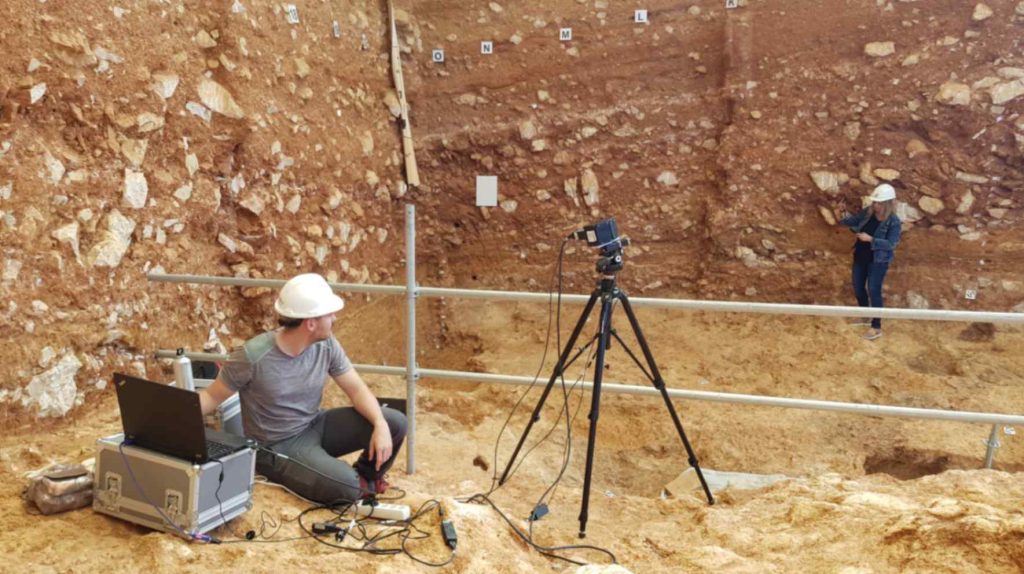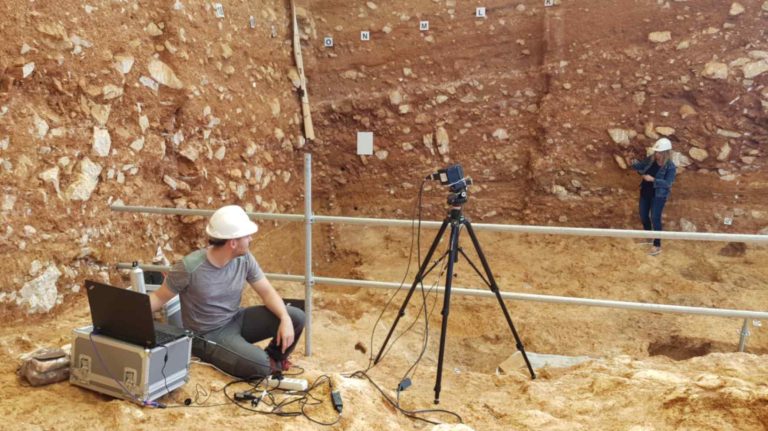Hyperspectral Imaging enables analysis of archaeological sites without excavation
CENIEH co-leads a pioneering study that, for the first time, applies hyperspectral imaging to effectively discriminate rock blocks, sediment matrices, and fossil remains within the stratigraphic deposits of the Gran Dolina site (Atapuerca).
The Centro Nacional de Investigación sobre la Evolución Humana (CENIEH) is co-leading a groundbreaking study that employs hyperspectral imaging (HSI) for the first time to non-invasively characterize the archaeo-paleoanthropological deposits of level TD10 at the Gran Dolina site (Sierra de Atapuerca, Burgos, Spain), thereby eliminating the need for physical excavation.
The study, published in the journal Heritage, was conducted by Berta García-Fernández from the Universidad Politécnica de Madrid (UPM), alongside Alfonso Benito-Calvo and Adrián Martínez-Fernández from CENIEH, in collaboration with researchers from the University of Málaga and the Institut Català de Paleoecologia Humana i Evolució Social in Tarragona.
HSI technology captures information from the terrain using hundreds of spectral bands—wavelengths of light invisible to the human eye. When combined with statistical classification algorithms, this technique enables the discrimination of visually similar materials and the generation of detailed stratigraphic maps of archaeological sites.
“Thanks to this technique, we can obtain new information about the composition and spatial distribution of sediments and archaeological remains without altering their context,” explains Alfonso Benito-Calvo, lead scientist at CENIEH’s Digital Cartography and 3D Analysis Laboratory.
TD10 Level
In the specific case of level TD10—one of the richest Middle Pleistocene occupation layers in Europe—the use of hyperspectral imaging has enabled a quantitative classification that spectrally differentiates rock blocks, sediment matrix, and fossil remains. This classification supports a more detailed spatial analysis of the layer and its formation processes.
“We collected the data using hyperspectral cameras under natural light conditions and from various distances, which demonstrates the technique’s excellent suitability for fieldwork,” notes Adrián Martínez Fernández, technician at the Digital Cartography and 3D Analysis Laboratory at CENIEH.

Heritage preservation
Beyond its value for archaeological research, hyperspectral analysis holds great potential for cultural heritage conservation and management. This advanced technique allows for rapid and efficient site documentation in a completely non-invasive, non-destructive manner—without damaging or altering the materials.
As Benito-Calvo emphasizes, “Hyperspectral imaging (HSI) is becoming an essential tool not only for accurately recording data, but also for supporting the preservation and better understanding of complex archaeo-paleoanthropological contexts. This is especially relevant in sites like Gran Dolina, where the density and richness of the archaeological record are truly exceptional.”
Bibliographic information:
Berta García-Fernández, Alfonso Benito-Calvo, Adrián Martínez-Fernández, Isidoro Campaña, Andreu Ollé, Palmira Saladié, María Martinón-Torres, and Marina Mosquera, “Hyperspectral Image Assessment of Archaeo-Paleoanthropological Stratigraphic Deposits from Atapuerca (Burgos, Spain)” Heritage 8 (2025), no. 6: 233, DOI: https://doi.org/10.3390/heritage8060233
Press release from Centro Nacional de Investigación sobre la Evolución Humana – CENIEH



